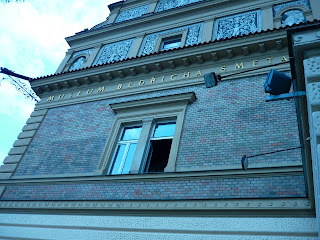The Vltava River (Moldau in German) as it flows north through Prague. The old castle complex is at the top of the hill in the background, with St. Vitus Cathedral dominating the skyline. The Vltava joins the Elbe in the Czech Republic and flows through Germany to the Baltic Sea. The Prague Castle is quite an architectural history lesson, including Romanesque and Gothic churches, the royal suites which represent several different styles, shops, servants quarters, gardens and so forth. It has been continually used for a thousand years, with exceptions, of course, unlike other large European palaces like Versailles or Schonbrunn which are essentially all from one era. Prague Castle has been the seat of Bohemian rulers, Holy Roman Emperors, and since the Czech Republic was created in the aftermath of World War I, Czech presidents.
Bedrich Smetana lived in Prague most of his life (mid 19th Century) and composed Ma Vlast here in the last few years of his life (after he had completely lost his hearing.) Ma Vlast means My Country or Fatherland, Homeland, something like that. One of the movements of Ma Vlast is entitled "Vltava" and we hear it often in the U.S. entitled with its German name, The Moldau.
The Charles Bridge, built in the late 14th Century.
The little estuary at the end of the Charles Bridge. The building on the right is the Smetana Museum.
The first movement of Ma Vlast is called Vysehrad. Vysehrad was a castle on this site which included a fort, the church, and cemetery. Smetana is buried here, as is Dvorak. The Hussites captured and destroyed much of this citadel during the Hussite wars which began with Hus's execution.
The main square in the city center. There is a memorial statue to Jan Hus in the middle. Hus was a priest and philosopher who was eventually burned at the stake in Constance, Switzerland, in 1415. He was from Bohemia and lived and preached there until taken to Constance. He was a reformer and supporter of the Englishman, John Wycliffe, who was declared a heretic at the same Council of Constance that condemned Jan Hus. Hus's death enraged his followers in Bohemia and led to riots and what we call the Hussite wars, which lasted on and off for about 15 years. The last two movements of Ma Vlast, Tabor and Blanik, are named after places in the Czech Republic connected with the Hussite Wars. Tabor is a city south of Prague that was the stronghold of the Hussites, and Blanik is a mountain where the defeated Hussites slumber and await the call of the homeland. Or so "they" say.
Many of what we refer to as religious wars in Europe had nationalistic as well as religious components, and the Hussite Wars certainly did. The English Reformation had a nationalistic component, which after separation from Rome led quickly to Catholic/Protestant wars. The European religious wars seem to have started in earnest as the Crusades were winding down; now we seem to be entering the Crusades again, Protestants and Catholics united against Muslims. After all these centuries of religious confict you'd think we'd be more interested in living in harmony and allowing each person to hold their own religious views unhampered by governmental interference. But you'd be wrong.
Bedrich Smetana lived in Prague most of his life (mid 19th Century) and composed Ma Vlast here in the last few years of his life (after he had completely lost his hearing.) Ma Vlast means My Country or Fatherland, Homeland, something like that. One of the movements of Ma Vlast is entitled "Vltava" and we hear it often in the U.S. entitled with its German name, The Moldau.
The Charles Bridge, built in the late 14th Century.
The little estuary at the end of the Charles Bridge. The building on the right is the Smetana Museum.
The first movement of Ma Vlast is called Vysehrad. Vysehrad was a castle on this site which included a fort, the church, and cemetery. Smetana is buried here, as is Dvorak. The Hussites captured and destroyed much of this citadel during the Hussite wars which began with Hus's execution.
The main square in the city center. There is a memorial statue to Jan Hus in the middle. Hus was a priest and philosopher who was eventually burned at the stake in Constance, Switzerland, in 1415. He was from Bohemia and lived and preached there until taken to Constance. He was a reformer and supporter of the Englishman, John Wycliffe, who was declared a heretic at the same Council of Constance that condemned Jan Hus. Hus's death enraged his followers in Bohemia and led to riots and what we call the Hussite wars, which lasted on and off for about 15 years. The last two movements of Ma Vlast, Tabor and Blanik, are named after places in the Czech Republic connected with the Hussite Wars. Tabor is a city south of Prague that was the stronghold of the Hussites, and Blanik is a mountain where the defeated Hussites slumber and await the call of the homeland. Or so "they" say.
Many of what we refer to as religious wars in Europe had nationalistic as well as religious components, and the Hussite Wars certainly did. The English Reformation had a nationalistic component, which after separation from Rome led quickly to Catholic/Protestant wars. The European religious wars seem to have started in earnest as the Crusades were winding down; now we seem to be entering the Crusades again, Protestants and Catholics united against Muslims. After all these centuries of religious confict you'd think we'd be more interested in living in harmony and allowing each person to hold their own religious views unhampered by governmental interference. But you'd be wrong.







2 comments:
I appreciate the lessons in history and musicology. Thanks, Dave!
Good memories of my visit there, but now I want to return! Nice posts, David! Martha Bacile Findlay
Post a Comment